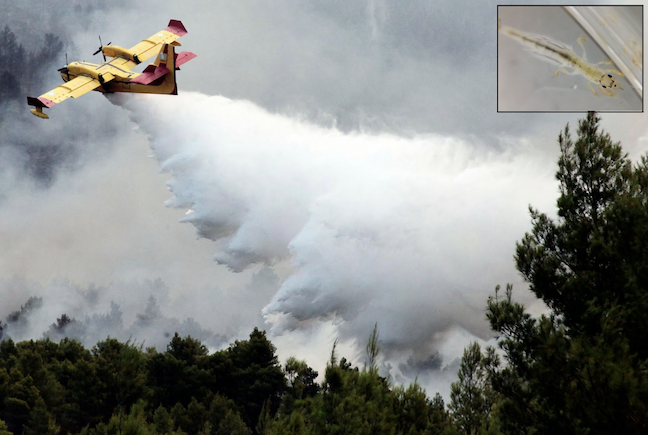March 2023 Science Corner: “Potential risk to aquatic biota from aerial application of firefighting water additives”


A recent paper published in the Environmental Pollution journal evaluated nine firefighting water additives (i.e., gels, retardants, and foams) used to combat wildland fires. The authors, Dr. Ryan Prosser and Jenna Anderson at the University of Guelph, assessed their toxicity to three aquatic vertebrates commonly found in freshwater ecosystems across North America.
Authors: J. Anderson, R.S. Prosser
Interview and story by: Gregg Verutes, PhD
Photo: An aerial application of firefighting water solution and mayfly larvae (upper right). Mayflies (Hexagenia spp) are sensitive benthic insects that only emerge at the end of life to mate and deposit eggs back in the water body. Credit: Shutterstock, R.S. Prosser
As I recently learned during a conversation with drinking water providers in Oregon, fires affect people and nature directly and indirectly. A coastal scientist by training, I was unaware of firefighting water additive solutions and their potential impacts on aquatic ecosystems and public health. These additives can enhance the efficacy and efficiency of efforts to extinguish forest fires. However, a lack of awareness about how these chemicals persist in the environment has led to over-spraying near wetlands, streams, and other water bodies. Consequently, adverse impacts to aquatic ecosystems and drinking water sources from aerial and ground use can occur directly (i.e., overhead spraying) or indirectly through run-off, leaching, or accidental release.
Perfluorinated chemicals (PFCs) formulated in firefighting additives were once common, and their toxicity to aquatic life is well documented. As concerns grew, a new brand of firefighting water additives – with claims of similar efficacy as PCFs but also “biodegradable” and “eco-friendly” – were produced. Little is known about next-generation additive formulations’ exact composition because patents often conceal them. Their use is increasing and becoming more widespread with increasing fire activity. Therefore, it is vital to understand the risks these substances pose as they bioaccumulate in freshwater organisms. Limited ecotoxicological data are available in the literature documenting the toxicity of firefighting water additives and guidelines for different products’ aerial application rates (e.g., volume per surface area).
A recent paper published in the Environmental Pollution journal evaluated nine firefighting water additives (i.e., gels, retardants, and foams) used to combat wildland fires. The authors, Dr. Ryan Prosser and Jenna Anderson at the University of Guelph, assessed their toxicity to three aquatic vertebrates commonly found in freshwater ecosystems across North America. The chemicals they tested in the lab are all used to fight Class A fires. These fires consist of wood, cardboard, and other ordinary combustibles and can occur in residential and forest fire settings. By controlling for other risk factors, such as water flow rates and the aquatic system’s depth, they found stark differences in the toxicity of these products.
The research team focused on each additive’s toxicity and how that might relate to the unintentional over-spraying of a small pond, stream, or lake. “Wouldn’t you choose the product that poses the least hazard risk to these systems?” Dr. Prosser asked. “If all are efficacious and similarly priced, then you would want to select the least negatively impactful one.” Their work found that the application concentrations recommended by manufacturers of some products would pose a risk to aquatic biota under real-world aerial application scenarios. Findings from this study also highlighted the importance of application buffers around water bodies and other regulations that could reduce the use of toxic chemicals or find safer alternatives.
Forest restoration is needed to mitigate the risk of wildfires and reduce the need for toxic water additives to put out fires. The evidence is clear that these chemicals can contaminate the environment, bioaccumulate, and ultimately threaten public health. As Blue Forest aims to protect biodiversity and source drinking water with conservation finance, more research is needed to understand how firefighting activities and potential treatments will impact nature’s benefits to people. For instance, many communities are concerned about the potential impacts of these fire retardants on human health, particularly if they enter drinking water sources. “There needs to be an integrated solution, and our research is just one step in narrowing the knowledge gap on firefighting additives,” added Prosser. Simply put, adaptively managing the application of firefighting water additives can prevent further ecological and financial losses following catastrophic wildfires. Read the full paper here.